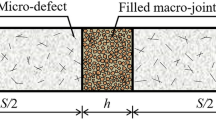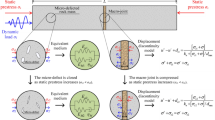Abstract
A split three-characteristics method was proposed that can be used to analyze the stress wave propagation through a rock mass with double-scale discontinuities (micro-defect (MD) and macro-joint (MJ)). The mechanisms of the effects of MDs and MJs on stress wave propagation were investigated. The characteristic lines were divided into the three basic elements of triangle, diamond and separated diamond elements to calculate the stress, strain and velocity of the stress wave propagation through a rock mass with double-scale discontinuities (MD-MJ). The results show that the effects of MJ on stress wave propagation are related to the macro-joint stiffness, while the effects of MDs on stress wave propagation are related to the viscous coefficient and propagation distance. The comparison of the stress wave propagation through MJs and MD-MJs shows that the traditional MJ model can be regarded as a special case of the present MD-MJ model and the effects of MDs can be neglected when the propagation distance is sufficiently short. However, when the propagation distance is long, the effects of MDs must be considered. The results also show that the present characteristics method can be used to investigate the stress wave propagation through double-scale discontinuities efficiently.








Similar content being viewed by others
References
Arash KA, Ehsan G, Pania N, Mathew S (2018) Elastic, viscoelastic, and strength properties of marcellus shale specimens. J Petrol Sci Eng 171:662–679
Bandis SC, Lumsden AC, Barton NR (1983) Fundamentals of rock joint deformation. Int J Rock Mech Min Sci Geomech Abstr 20(6):249–268
Cai JG, Zhao J (2000) Effects of multiple parallel fractures on apparent attenuation of stress waves in rock masses. Int J Rock Mech Min Sci 37(4):661–682
Chen X, Li JC, Cai MF, Zou Y, Zhao J (2016) A further study on wave propagation across a single joint with different roughness. Rock Mech Rock Eng 49(7):2701–2709
Cook NGW (1992) Natural joints in rock: mechanical, hydraulic and seismic behaviour and properties under normal stress. Int J Rock Mech Min Sci Geomech Abstr 29(3):198–223
David EC, Brantut N, Schubnel A, Zimmerman RW (2012) Sliding crack model for nonlinearity and hysteresis in the uniaxial stress–strain curve of rock. Int J Rock Mech Min Sci 52:9–17
Deng XF, Zhu JB, Chen SG, Zhao J (2012) Some fundamental issues and verification of 3DEC in modeling wave propagation in jointed rock masses. Rock Mech Rock Eng 45(5):943–951
Deng XF, Zhu JB, Chen SG, Zhao ZY, Zhou YX, Zhao J (2014) Numerical study on tunnel damage subject to blast-induced shock wave in jointed rock masses. Tunn Undergr Space Technol 43:88–100
Fakhimi AA, Fairhurst C (1994) A model for the time-dependent behavior of rock. Int J Rock Mech Min Sci Geomech Abstr 31(2):117–126
Fan LF, Ren F, Ma GW (2011) An extended displacement discontinuity method for analysis of stress wave propagation in viscoelastic rock mass. J Rock Mech Geotech Eng 3(1):73–81
Fan LF, Ma GW, Li JC (2012) Nonlinear viscoelastic medium equivalence for stress wave propagation in a jointed rock mass. Int J Rock Mech Min Sci 50:11–18
Fan LF, Wang LJ, Wu ZJ (2018) Wave transmission across linearly jointed complex rock masses. Int J Rock Mech Min Sci 112:193–200
Feng P, Dai F, Liu Y, Xu NW, Zhao T (2018) Effects of strain rate on the mechanical and fracturing behaviors of rock-like specimens containing two unparallel fissures under uniaxial compression. Soil Dyn Earthq Eng 110:195–211
Hu B, Pan PZ, Ji WW, Miao S, Yao T (2020) Study on probabilistic damage constitutive relation of rocks based on maximum-entropy theory. Int J Geomech 20(2):06019018
Hudson JA, Pointer T, Liu E (2001) Effective-medium theories for fluid-saturated materials with aligned cracks. Geophys Prospect 49(5):509–522
Ichikawa Y, Kawamura K, Uesugi K, Seo YS, Fujii N (2011) Micro- and macrobehavior of granitic rock: observations and viscoelastic homogenization analysis. Comput Methods Appl Mech Eng 191(1):47–72
Jaeger JC, Cook NGW, Zimmerman RW (2007) Fundamentals of rock mechanics, 4th edn. Wiley-Blackwell, Malden
Kolsky H (1953) Stress waves in solids. Clarendon Press, Oxford
Li JC (2013) Wave propagation across non-linear rock joints based on time-domain recursive method. Geophys J Int 193(2):970–985
Li JC, Ma GW, Zhao J (2010) An equivalent viscoelastic model for rock mass with parallel joints. J Geophys Res 115:B03305
Li JC, Li HB, Ma GW, Zhou YX (2013) Assessment of underground tunnel stability to adjacent tunnel explosion. Tunn Undergr Space Technol 35:227–234
Li JC, Li HB, Zhao J (2015a) An improved equivalent viscoelastic medium method for wave propagation across layered rock masses. Int J Rock Mech Min Sci 73:62–69
Li HB, Liu YQ, Li JC, Yang FW, Liu TT, Xia X, Liu B (2015b) Numerical study on oblique incidence across rock masses with linear and nonlinear joints. Arab J Geosci 9:20
Li JC, Rong LF, Li HB, Hong SN (2019) An SHPB test study on stress wave energy attenuation in jointed rock masses. Rock Mech Rock Eng 52:403–420
Ma GW, Fan LF, Li JC (2013) Evaluation of equivalent medium methods for stress wave propagation in jointed rock mass. Int J Numer Anal Methods Geomech 37(7):701–715
Markov M, Levine V, Mousatov A, Kazatchenko E (2005) Elastic properties of double-porosity rocks using the differential effective medium model. Geophys Prospect 53(5):733–754
Mindlin RD (1960) Waves and vibrations in isotropic elastic plates. Struct Mech 1996:199–232
Müller TM, Gurevich B, Lebedev M (2010) Stress wave attenuation and dispersion resulting from wave-induced flow in porous rocks—a review. Geophysics 75(5):147–164
Niu LL, Zhu WC, Li SH, Guan K (2018) Determining the viscosity coefficient for viscoelastic wave propagation in rock bars. Rock Mech Rock Eng 51(5):1347–1359
Peng J, Wong LNY, Teh CI (2017) Effects of grain size-to-particle size ratio on micro-cracking behavior using a bonded-particle grain-based model. Int J Rock Mech Min Sci 100:207–217
Pyrak-Nolte LJ, Myer LR, Cook NGW (1987) Seismic visibility of fractures. Rock Mech 28:47–56
Pyrak-Nolte LJ, Myer LR, Cook NGW (1990) Anisotropy in seismic velocities and amplitudes from multiple parallel fractures. J Geophys Res 95(B7):11345–11358
Ren F, Fan LF, Ma GW (2011) Simulation of viscoelastic behavior of defected rock by using numerical manifold method. Front Struct Civ Eng 5(2):199–207
Schoenberg M (1980) Elastic wave behavior across linear slip interfaces. J Acoust Soc Am 68(5):1516–1521
Wang LL (2005) Foundation of stress waves, 2nd edn. National Defense Industry Press, Beijing
Wang LL, Labibes K, Azari Z, Pluvinage G (1994) Generalization of split hopkinson bar technique to use viscoelastic bars. Int J Impact Eng 15(5):669–686
Xi DY, Xu SL (2016) Rock physics and constitutive theory eng. Press of University of Science and Technology of China, Hefei
Yu J, Song BX, Qian QH (2012) Study of propagation of P-waves in dual nonlinear elastic rock medium with one set of joints. Chin J Rock Mech Eng 31(12):2400–2411
Zhao J, Cai JG (2001) Transmission of elastic p-waves across single fractures with a nonlinear normal deformational behavior. Rock Mech Rock Eng 34(1):3–22
Zhao XB, Zhao J, Cai JG (2010) P-wave transmission across fractures with nonlinear deformational behaviour. Int J Numer Anal Methods Geomech 30(11):1097–1112
Zhu J, Hu SS, Wang LL (2009) An analysis of stress uniformity for concrete-like specimens during SHPB tests. Int J Impact Eng 36:61–72
Acknowledgements
The research is supported by the National Natural Science Foundation of China (NSFC) (Nos. 51778021 and 11572282).
Author information
Authors and Affiliations
Corresponding author
Ethics declarations
Conflict of interest
The authors declare that they have no conflict of interest.
Additional information
Publisher's Note
Springer Nature remains neutral with regard to jurisdictional claims in published maps and institutional affiliations.
Rights and permissions
About this article
Cite this article
Fan, L., Wang, M. & Wu, Z. A Split Three-Characteristics Method for Stress Wave Propagation Through a Rock Mass with Double-Scale Discontinuities. Rock Mech Rock Eng 53, 5767–5779 (2020). https://doi.org/10.1007/s00603-020-02233-w
Received:
Accepted:
Published:
Issue Date:
DOI: https://doi.org/10.1007/s00603-020-02233-w




